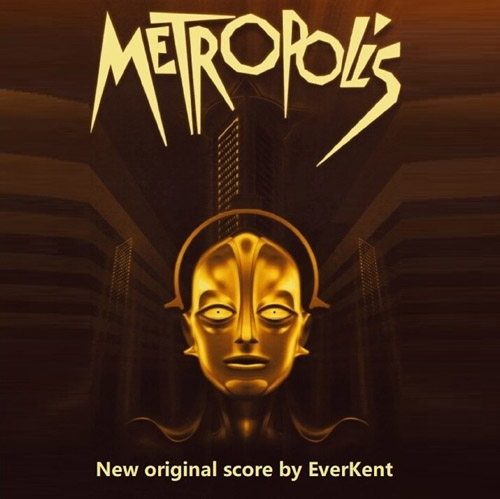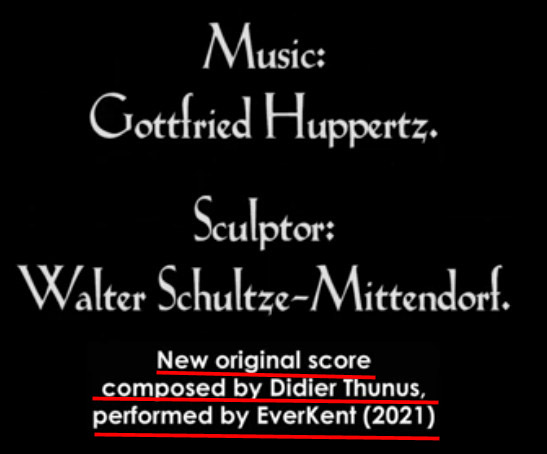No |
Name |
Didier's explanation for every track |
Listen |
01 |
Metropolis #1 (Overture) |
The restored version starts with an explanation of the restoration process. This gives the opportunity of introducing the Metropolis theme in the form of an overture.
|
|
02 |
Immineo #1 (Opening Credits) |
After the opening credits roll, the viewer is introduced to the factory gears and pumps under an ominous theme that develops into an orchestral outburst.
|
|
03 |
The Shift #1 (Underground Workers) |
Underground workers line up for the shift. The new team takes the lift down to the subterranean factory. The music creates a military backdrop to the orderly movements of the marching workers.
|
|
04 |
The Carefree Days |
In contrast, the rich class is enjoying a free life of bodily pleasures such as sports and seduction. This will be the only moment of relaxed and peaceful music.
|
|
05 |
Maria and Freder #1 (The Children) |
Freder is interrupted in his recreation in the gardens by the vision of Maria emerging like a ghost, surrounded by children. A female voice introduces the love theme that will recur throughout the movie.
|
|
06 |
The World Below |
Fascinated by this vision, Freder tries to follow Maria and finds himself in the subterranean factory, witnessing a tragedy when the workplace blows up. The military ambience comes back and explodes as a stunned Freder has a vision of Moloch, a god to which human lives are sacrificed.
|
|
07 |
Metropolis #2 (The City) |
He runs in order to announce the disaster to his father, who is the owner of the factory. The Metropolis theme comes back on the images of the futuristic city.
|
|
08 |
Father and Son |
His father, Joh Fredersen, finally accepts to listen to him and blames his clerk, Josaphat, for not having told him about the tragedy.
|
|
09 |
The Dismissal |
When Grot, the representant of the workers, arrives with other bad news – the workers seem to be plotting against their superiors – Fredersen decides to fire Josaphat. The latter goes away in disarray and Freder follows him to try to cheer him up. The music captures the contrasting feelings of the protagonists.
|
|
10 |
Metropolis #3 (The Swap) |
Freder decides to take action in the defence of the workers and goes underground in order to swap places with Georgy, one of theoperativesmachinists. The latter must go hide in Josaphat's place, but gets distracted by the invitation to a party. The Metropolis theme comes back, leaving way to a party theme towards the end.
|
|
11 |
The Mad Scientist #1 (Prelude to the Robot) |
Fredersen visits Rotwang, an inventor, who appears to be trying to revive Hel, Fredersen's late wife. The gloomy music underlines the scientist's apparent madness.
|
|
12 |
Futura #1 (Introductions) |
Rotwang introduces him to a robot of female appearance, named Futura, whom he says will impersonate Hel. The electronic theme of the robot kicks in.
|
|
13 |
The Plan |
Together they scheme a plan in order to take control again of the situation underground, as Freder goes through the strains of a worker's day. The music is reflective in order to underscore the scheming, and repetitive to underline the harshness of Freder’s labour.
|
|
14 |
The Shift #2 (Catacombs) |
The next shift arrives. Exhausted, Freder follows the other workers to the catacombs. The military theme is back, alternating with a softer version of it as Fredersen and Rotwang decide to find out about the workers' transgressions.
|
|
15 |
The Prophet |
The workers are listening to a woman preaching to them, who appears to be Maria. She tells the story of the Tower of Babel, whose construction failed because there wasn't a mediator between the head, i.e. the leaders, and the hands, i.e. the workers. The theme is severe and develops into an ethnic recitation as a workforce is assembled to build the tower.
|
|
16 |
Echoes of the Underground #1 (The Chosen) |
A person must arrive who will play the role of this mediator, says Maria. A new emotional theme is introduced as the images allude to the fact that Freder may well be the chosen in question.
|
|
17 |
Maria and Freder #2 (The Kiss) |
When everybody leaves, Maria and Freder fall in each other's arms, with the return of the love theme. They are being observed by Fredersen and Rotwang, who decide to kidnap Maria and to give Futura her appearance. Rotwang plays the game but hides his real intentions.
|
|
18 |
Immineo #2 (Shadows and Skulls) |
When Freder leaves, Rotwang follows Maria in the catacombs and abducts her. The Immineo theme returns to underline the threat and the menace.
|
|
19 |
Metropolis #4 (The Monk) / Babylon #1 (The Crypt) |
Freder finds himself amongst men and women praying, listening to a monk, and is then confronted in a crypt to a representation of death and of the seven deadly sins. This piece combines the premises of the Metropolis theme with a glimpse at the Futura theme as Rotwang is seen telling the robot to destroy Fredersen, and a first version of the Babylon theme.
|
|
20 |
The Crossover |
Georgy is caught by the Thin Man, Fredersen's sleuth, who gets hold of Josaphat’s address. He visits the latter, seconds after Freder has left the place, but still discovers evidence of Josaphat, Freder and Georgy teaming up in favour of the workers. The music oscillates between menace, suspicion and scheming.
|
|
21 |
Maria's Cry |
Maria resists and cries as she is being taken by Rotwang for his experiment. Freder happens to be walking in the streets at the same moment, and to hear her. He locates the door of the house where she is being detained. The tense and palpitating music underscores the fight between Maria and Rotwang. He eventually benumbs her.
|
|
22 |
Haunted House |
The door opens as Freder is fiercely knocking at it. The music gets spooky, whereas Freder starts to explore the place, giving it the feel of a haunted house. He finally finds Maria’s scarf, but remains locked in a room.
|
|
23 |
Futura #2 (Metamorphosis) |
Rotwang conducts its operation to give Futura the looks of Maria, as the latter lies unconscious. The metamorphosis is successful, with this ferocious return of the robot theme.
|
|
| 24 |
The Mad Scientist #2 (One Last Thing) |
A door opens to Freder again and he is able to talk to Rotwang. The scientist tells him that Maria is now with Freder’s father. The spooky music is a homage to Maestro Ennio Morricone, quoting explicitly his theme for John Carpenter’s The Thing.
|
|
| 25 |
Vision of Horror |
Freder rushes to his father’s office, only to find him with Futura/Maria, whom Freder believes to be Maria. Under the shock, he has hallucinations and falls unconscious.
|
|
| 26 |
Babylon #2 (The Dance) |
During a gathering of aristocrats, a dancing Futura/Maria entertains and beguiles the crowd. Her magnetism manages to drive them insane. In his healing bed, Freder has visions of the Thin Man transformed into a monk preaching the holy scriptures, and his lecture merges with the dancing of Futura/Maria. The music makes use of the Babylon theme in a rhythmic and ethnic way, and turns to a more sacred feel as the embodiments of death and the deadly sins appear in Freder’s delirium.
|
|
27 |
Furioso |
Freder has recovered and meets with Josaphat, who tells him how, during Freder’s absence, a woman named Maria has bewildered the men to a point that they started killing each other in duels or fights. The music gets quieter but still sinister and with hints to the Babylon theme and to the party theme.
|
|
28 |
The Fake Prophet |
As the real Maria is still detained by Rotwang, the fake one is preaching to the workers, telling them that the chosen is not going to come after all. She gets interrupted by Freder, who claims she is not Maria. Ensues a fight where Georgy gets stabbed. The music goes from offhand to dissonant to dramatic as the plot plunges into the horror.
|
|
29 |
Echoes of the Underground #2 (Death of Georgy) |
Georgy dies in the arms of Freder, on this repeat of the emotional theme.
|
|
30 |
The Revolt #1 (Swarming the Underground) |
Led and perverted by Maria, the workers decide the swarm the underground in order to destroy the machines. The music creates a dark and foreboding mood through a dynamic range and dissonant harmonies, as in Prokofiev’s Dance of the Knights.
|
|
31 |
The Revolt #2 (The Phone Call) |
Alarmed by the assault, Grot seeks Frederson’s help during a phone call, but in vain |
|
32 |
The Flood |
The machines are being destroyed, causing the city to malfunction, and giving way to floods and earthquakes. Maria, who managed to escape from Rotwang’s claws, strives to save the children from the devastation. The music becomes overwhelming and obsessive.
|
|
33 |
Maria and Freder #3 (City Collapse) |
As the disaster grows and Freder and Josaphat come to the rescue, the two lovers are reunited on this third version of the love theme.
|
|
34 |
Tarantella |
The children and their rescuers proceed to quickly move to a higher place in order to escape the deluge. In parallel, the workers have gone completely demented as they dance in the devastated factory. Grot tries to bring them back to the reason by reminding them that their kids are in big danger.
|
|
35 |
The Party |
Futura/Maria managed to drive insane not only the workers but also the ruling class, now embarked in an ecstatic party, on this full version of the party theme.
|
|
36 |
March of the Dungarees |
Grot and the workers are now marching through the city, searching for the “witch”, i.e. Futura/Maria, whom they claim is the reason for all their griefs. The music is martial and austere.
|
|
37 |
Witch Hunting |
They find Maria and start chasing her. The crowd of workers merges with the party people, and they finally capture Futura/Maria, whereas the real Maria now gets chased by Rotwang again. Action music amplifies the panic.
|
|
38 |
The Bonfire |
Futura/Maria is brought to a bonfire as the workers decide to burn the witch. Freder thinks she is the real Maria and tries to save her, in vain. The music is solemn and funereal. Under the effect of the fire, Futura/Maria turns back to her robot appearance, and Freder turns his attention to the top of the cathedral where Rotwang is about to catch Maria. |
|
39 |
Cathedral Fight |
He rushes to her rescue and fights with Rotwang. His father has now joined the crowd, but the action music turns to an engaging melody as Josaphat manages to calm them down by saying that their kids have been saved. But the fight continues and, finally, Rotwang falls to his death from the rooftop.
|
|
40 |
The Resolution |
The workers now march to the cathedral in order to demand accounts. Freder and Maria insist on Grot to make peace with Fredersen. Freder finally manages to play the role of mediator as he convinces the two men to shake hands. The music finale illustrates the reconciliation and the new harmony that will now reign over the city of Metropolis.
|
|
|
|













